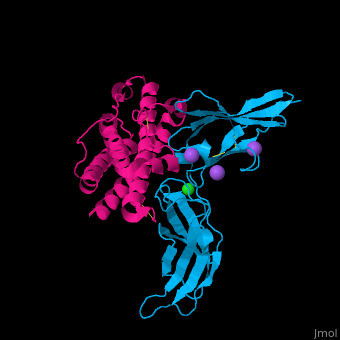Prolactin receptor
From Proteopedia
| |||||||||||
3D structures of prolactin receptor
Updated on 12-January-2023
3mzg – hPRLR extracellular domain + hPRL - human
3d48, 3n06, 3n0p, 3ncb – hPRLR extracellular domain + hPRL (mutant)
3ncc, 3nce, 3ncf – hPRLR extracellular domain (mutant) + hPRL (mutant)
3ew3, 3npz – rPRLR extracellular domain + hPRL - rat
4i18 - hPRLR extracellular domain + antibody
2lfg - hPRLR extracellular domain d2 - NMR
1f6f – rPRLR extracellular domain + placental lactogen
1bp3 – hPRLR extracellular domain + growth hormone
References
- ↑ Kline JB, Roehrs H, Clevenger CV. Functional characterization of the intermediate isoform of the human prolactin receptor. J Biol Chem. 1999 Dec 10;274(50):35461-8. PMID:10585417
- ↑ Clevenger CV. Role of prolactin/prolactin receptor signaling in human breast cancer. Breast Dis. 2003;18:75-86. PMID:15687690
- ↑ Kulkarni MV, Tettamanzi MC, Murphy JW, Keeler C, Myszka DG, Chayen NE, Lolis EJ, Hodsdon ME. Two independent histidines, one in human prolactin and one in its receptor, are critical for pH dependent receptor recognition and activation. J Biol Chem. 2010 Sep 30. PMID:20889499 doi:10.1074/jbc.M110.172072

